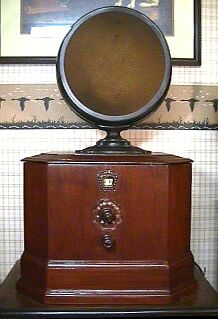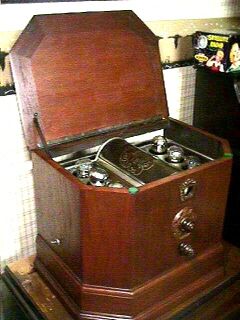| 1940 DeForest Radio | |
 |
This 1940 DeForest 10da561, made for DeForest Radio by Rogers-Majestic. The cabinet is original as found. I had the radio for many years and could not solve a severe distortion (garbled sound) problem, I recently found the schematic on an RCC CD (see links). It turns out that someone had removed the power transformer and was running the thing hot - no it wasn't an AC DC set as I assumed (an ass of you and me). At first I thought that I had the wrong schematic, after all my radio had no power transformer. Closer inspection revealed several holes hiding under the dust where the transformer had been mounted. |
|
This radio uses series wired heater filaments - so the original Mr. Fixit thought he could just run the rest of the circuit live. Unfortunately he didn't get the audio grid biasing right, thus the garbled sound distortion. After about a week of re-wiring (adding a transformer) and undoing the original re-wire job, I got it running - a very nice radio. I used a small 115v bathroom shaver isolation transformer. The original used a 240v centertap transformer to get full wave rectification - but a slightly larger filter cap and half wave works just dandy. By the way the knobs are not the ones that were on the radio, they are however original. I had bought a 50's Canadian Philips radio/phono unit - just for parts. Turns out after talking to a collector in BC with the same radio it had the correct knobs for my DeForest. Apparently Philips had bought Rogers and probably continued to use some of the old Rogers stock for a long time to come. |
|

